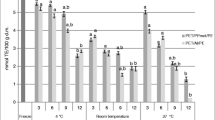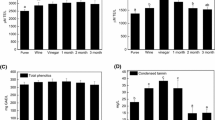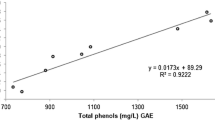Abstract
The addition of maltodextrin DE 10 to red wine (Cabernet Sauvignon) followed by freeze-drying allowed to obtain a free-flowing (dealcoholized) wine powder (WP) having a phenolic concentration about 3.6 times higher than the original liquid red wine. The powder, having a water activity (a w) of 0.053 and 0.330 was stored at 28 °C and 38 °C and the content of ten different phenolic compounds was determined by HPLC. Caftaric acid, quercetin 3-glucoside, caffeic acid, gallic acid and resveratrol contents in the WP stored at 28 °C and 38 °C, remained almost constant during 70 days of storage, while epicatechin gallate, catechin, malvidin 3-G and epicatechin showed slight losses (about 15–25 %) during storage. On the contrary, epigallocatechin experienced a strong loss of concentration (around 61 % loss) during storage at the same conditions. A moderate decrease of antioxidant activity, determined by free radical scavenging capacity of the 2,2-diphenyl-1-picrylhydrazyl free radical (DPPH*) and ferric reducing antioxidant power (FRAP) was observed along storage. This decrease was more important at higher temperature (38 °C) and higher a w (0.33). These results would allow the feasibility of using this WP as a healthy ingredient in alcohol-free powder drinks.







Similar content being viewed by others
References
Altiok, E., Bayraktar, O., & Tihminlioglu, F. (2009). Stability of trans-resveratrol incorporated in chitosan microspheres. Biomedical Engineering Meeting, BIYOMUT 2009. 14th National. doi:10.1109/BIYOMUT.2009.5130340.
Ananingsih, V. K., Sharma, A., & Zhou, W. (2011). Green tea catechins during food processing and storage: a review on stability and detection. Food Research International. doi:10.1016/j.foodres.2011.03.004.
Anli, R. E., & Vural, N. (2009). Antioxidant phenolic substances of Turkish red wines from different regions. Molecules, 14, 289–297.
Avalos Llanos, K. R., Sgroppo, S. C., & Avanza, J. (2003). Actividad antioxidante y contenido en fenoles totales en vinos de origen nacional. FACENA, 19, 11–19.
Benzie, I. F. F., & Strain, J. J. (1996). The ferric reducing ability of plasma (FRAP) as a measurement of “antioxidant power”: the FRAP assay. Analytical Biochemistry, 239, 70–76.
Birse, M., Pollnitz, A., Kwiatkowski, M., Gockowiak, H., Parker, M., Eglinton, J., & Herderich, M. (2004). Anthocyanins, anthocyanin-derived pigments and the colour of red wine. Proceedings of the 12th World Congress of Food Science and Technology.
Brouillard, R., George, F., & Fougerousse, A. (1997). Polyphenols produced during red wine ageing. BioFactors, 6, 403–410.
Buera, M. P., Welti-Chanes, J., Lillford, P., & Corti, H. R. (2006). Water properties of food, pharmaceutical and biological materials. CRC, Taylor & Francis. United States of America.
Burin, V. M., Lima da Silva, A., Malinovsky, L. I., Rosier, J. P., Falcao, L. D., & Bordignon-Luiz, M. T. (2011). Characterization and multivariate classification of grapes and wines of two Cabernet Sauvignon clones. Pesquisa Agropecuária Brasileira, 46, 474–481.
Camussoni, G., & Carnevali, E. (2004). Determinación comparativa del contenido de polifenoles en vinos tintos de origen Argentino. Invenio, 7, 151–159.
Chranioti, C., & Tzia, C. (2012). Binary mixtures of modified starch, maltodextrin and chitosan as efficient encapsulating agents of fennel oleoresin. Food and Bioprocess Technology: 1–9, doi. 10.1007/s11947-012-0966-7.
Cioroi, M., & Musat, C. L. (2007). Investigations on the correlations between polyphenol content from red wines and their antioxidant capacity. Cercetari Agronomice in Moldova, 4, 35–42.
Cvejic, J. M., Djekic, S. V., Petrovic, A. V., Atanackovic, M. T., Jovic, J. M., Brceski, I. D., & Gojkovic-Bukarica, L. C. (2010). Determinatinon of trans- and cis-resveratrol in Serbian commercial wines. Journal of Chromtographic Science, 48, 229–234.
Díaz, B., Gomes, A., Freitas, M., Fernandes, E., Nogueira, D. R., González, J., Moure, A., Levoso, A., Vinardell, M. P., Mitjans, M., Domínguez, H., & Parajó, J. C. (2012). Valuable polyphenolic antioxidants from wine vinasses. Food and Bioprocess Technology, 5, 2708–2716.
Estupiñan, D.C., Schwartz, S.J. & Garzón, G.A. (2011). Antioxidant activity, total phenolics content, anthocyanin, and color stability of isotonic model beverages colored with andes berry (rubus glaucus benth) anthocyanin powder. Journal of Food Science, 76, s26–s34.
Fanzone, M., Peña-Neira, A., Jofré, V., Assof, M., & Zamora, F. (2010). Phenolic characterization of Malbec wines from Mendoza province (Argentina). Journal of Agricultural and Food Chemistry, 58, 2388–2397.
Favetto, G. J., Resnik, S. L., Chirife, J., & Ferro Fontán, C. (1983). Statistical evaluation of water activity measurements obtained with the Vaisala Humicap humidity meter. Journal of Food Science, 48, 534–537.
Friedman, M., Levin, C. E., Lee, S. U., & Kozukue, N. (2009). Stability of green tea catechins in commercials tea leaves during storage for 6 months. Journal of Food Science, 74, H47–H51.
Galmarini, M. V. (2010). Estudios sensoriales y fisicoquímicos del disacárido trehalosa en relación a su uso como ingrediente funcional en alimentos. PhD thesis, Facultad de Farmacia y Bioquímica, Universidad de Buenos Aires, Buenos Aires, Argentina.
Galmarini, M. V., van Baren, C., Zamora, M. C., Chirife, J., Bandoni, A., & Di Leo Lira, P. (2011). Impact of trehalose and other carbohydrates addition on aroma retention in freeze dried strawberry puree. International Journal of Food Science and Technology, 46(7), 1329–1336.
Gambelli, L. & Santaroni, G.P. (2004). Polyphenols content in some Italian red wines of different geographical origins. Journal of Food Composition and Analysis, 17, 613–618.
Giovanelli, G., & Brenna, O. V. (2007). Oxidative stability of red wine stored in packages with different oxygen permeability. European Food Research and Technology, 226, 169–179.
Giusti, M.M. & Wrolstad, R.E. (2001). Characterization and measurement of anthocyanins by UV-visible spectroscopy. In: Current Protocols in Food Analytical Chemistry (edited by R. Wrolstad, T. Acree, H. An, E. Decker, M. Penner, D. Reis, S. Schwartz, C. Shoemaker & P. Sporns). 1st edn. Pp. F1.2.1–F1.2.13, New York, NY: John Wiley & Sons, Inc..
Gorelik, S., Ligumsky, M., Kohen, R., & Kanner, J. (2008). A novel function of red wine polyphenols in humans: prevention of absorption of cytotoxic lipid peroxidation products. The FASEB Journal, 22, 41–46.
Hukkanen, T., Pölönen, S., Kärenlampi, O., & Kokko, H. (2006). Antioxidant capacity and phenolic content of sweet rowanberries. Journal of Agricultural and Food Chemistry, 54, 112–119.
International Organization of Vine and Wine (2009). Recueil international des methodes d’analyses. Indice de Folin–Ciocalteu. Method OIV-MA-AS2-10, 2009.
Jeandet, P., Bessis, R., Sbaghi, M., Meunier, P., & Trollat, P. (1995). Resveratrol content of wines of different ages: relationship with fungal disease pressure in the vineyard. American Journal of Enology and Viticulture, 46, 1–4.
Kallithraka, S., Salacha, M. I., & Tzourou, I. (2009). Changes in phenolic composition and antioxidant activity of white wine during bottle storage: accelerated browning test versus bottle storage. Food Chemistry, 113, 500–505.
Klopotek, Y., Otto, K., & Bohm, V. (2005). Processing strawberries to different products alters content of vitamin C, total phenolics, total anthocyanins and antioxidant capacity. Journal of Agricultural and Food Chemistry, 53, 5640–5646.
Kruma, Z., Karklina, D., Cinkmanis, I., & Rutkovska, O. (2010). Polyphenolic composition and free radical scavenging activity of red wines available in the Latvian market. Chemine Technologija, 54, 56–61.
Laine, P., Kylli, P., Heinonen, M., & Jouppila, K. (2008). Storage stability of microencapsulated cloudberry (Rubus chamaemorus) phenolics. Journal of Agricultural and Food Chemistry, 56, 11251–11261.
Li, N., Taylor, L. S., & Mauer, L. J. (2011). Degradation kinetics of catechins in green tea powder: Effects of temperature and relative humidity. Journal of Agriculture and Food Chemistry, 59, 6082–6090.
Marc, F., Davin, A., Deglene-Benbrahim, L., Ferrand, C., Baccaunaud, M., & Fritsch, P. (2004). Méthodes d’évaluation du potentiel antioxidant dans les aliments. Médecine Sciences, 20, 458–463.
Mazza, G., Fukumoto, L., Delaquis, P., Girard, B., & Ewert, B. (1999). Anthocyanins, phenolics, and color of cabernet Franc, merlot, and pinot noir wines from British Columbia. Journal of Agricultural and Food Chemistry, 47, 4009–4017.
Midgley, J. (1971). Drinking and attitudes towards drinking in a Muslim community. Quarterly Journal of Studies on Alcohol, 32(1-A), 148–158.
Munin, M., & Edwards-Lévy, F. (2011). Encapsulation of natural polyphenolic compounds; a review. Pharmaceutics, 3, 793–829.
Nadeem, H. S., Torun, M., & Ozdemir, F. (2011). Spray drying of the mountain tea (Sideritis stricta) water extract by using different hydrocolloid carriers. LWT- Food Science and Technology, 44, 1626–1635.
Nikfardjam Pour, M. S., Márk, L., Avar, P., Figler, M., & Ohmacht, R. (2006). Polyphenols, anthocyanins, and trans-resveratrol in red wines from the Hungarian Villány region. Food Chemistry, 98, 453–462.
Osorio, C., Acevedo, B., Hillebrand, S., Carriazo, J., Winterhalter, P., & Morales, A. L. (2010). Microencapsulation by spray-drying of anthocyanin pigments from Corozo (Bactris guineensis) fruit. Journal of Agricultural and Food Chemistry, 58, 6977–6985.
Ou, B., Huang, D., Hampsch-Woodill, M., Flanagan, J. A., & Deemer, E. K. (2002). Analysis of antioxidant activities of common vegetables employing Oxygen Radical Absorbance Capacity (ORAC) and Ferric Reducing Antioxidant Power (FRAP) assays: a comparative study. Journal of Agricultural and Food Chemistry, 50, 3122–3128.
Radovanovic, B., & Radovanovic, A. (2010). Free radical scavenging activity and anthocyanin profile of Cabernet Sauvignon wines from the Balkan region. Molecules, 15, 4213–4226.
Ratola, N., Fari, J. L., & Alves, A. (2004). Analysis and quantification of trans-resveratrol in wines from Alentejo Region (Portugal). Food Technology and Biotechnology, 42, 125–130.
Rattanadechsakul, P., Rattanadechsakul, J., Okonogi, S., & Yotsawimonwat, S. (2007). Stability of bioactive compounds and antioxidant activity of Echinaceaof purpurea extract. XVth International Workshop on Bioencapsulation, Vienna, Austria, Sept 6–8, pp. 1–4.
Renaud, S., & de Lorgeril, M. (1992). Wine, alcohol, platelets, and the French paradox for coronary heart disease. The Lancet, 339(8808), 1523–1526.
Ribereau-Gayon, P., & Stonestreet, E. (1968). Le dosage des anthocyanes dans le vin rouge. Bulletin de la Société Chimique de France, 47, 2649–2652.
Roos, Y. (1995). Phase transitions in foods. New York, USA: Academic Press.
Roos, Y., & Karel, M. (1991). Phase transitions of mixtures of amorphous polysaccharides and sugars. Biotechnology Progress, 7, 49–53.
Salas, E., Atanasova, V., Poncet-Legrand, C., Meudec, E., Mazauric, J. P., & Cheynier, V. (2004). Demonstration of the occurrence of flavanol–anthocyanin adducts in wine and in model solutions. Analytica Chimica Acta, 513, 325–332.
Sanchez, V., Baeza, R. I., Galmarini, M. V., Zamora, M. C., & Chirife, J. (2011). Freezedrying encapsulation of red wine polyphenols in an amorphous matrix of maltodextrin. Food and Bioprocess Technology. doi:10.1007/s11947-011-0654-z.
Singleton, V. L., & Rossi, J. A., Jr. (1965). Colorimetry of total phenolics with phosphomolybdic–phosphotungtic acid reagent. American Journal of Enology and Viticulture, 16, 144–158.
Soulat, T., Philippe, C., dit Sollier, C. B., Brezillon, C., Berge, N., Teissedre, P. L., Callebert, J., Rabot, R., & Drouet, L. (2006). Wine constituents inhibit thrombosis but not atherogenesis in C57BL/6 apolipoprotein Edeficient mice. British Journal of Nutrition, 96, 290–298.
Souquet, J. -M., Veran, F., Mané, C., & Cheynier, V. (2006). Optimization of extraction conditions on phenolic yields from the different parts of grape clusters. Quantitative distribution of their proanthocyanidins. XXIII International Conference on Polyphenols Winipeg (Manitoba, Canada), pp 245–246.
Stratil, P., Klejdus, B., & Kuban, V. (2006). Determination of total content of phenolic compounds and their antioxidant activity in vegetables – evaluation of spectrophotometric methods. Journal of Agricultural and Food Chemistry, 54, 607–616.
Stratil, P., Kubá, V., & Fojtová, J. (2008). Comparison of the phenolic content and total antioxidant activity in wines as determined by spectrophotometric methods. Czech Journal of Food Science, 26, 242–253.
Tandale, S. R. (2007). Microencapsulation of vitamin c and gallic acid in whey protein concentrate by spray and freeze drying — characterization and degradation kinetics. PhD thesis, Graduate Faculty of the University of Georgia, Athens, GA.
Tonon, R. V., Brabet, C., & Hubinger, M. D. (2010). Anthocyanin stability andantioxidant activity of spray-dried açai (Euterpe oleracea Mart.) juice produced with different carrier agents. Food Research International, 43, 907–914.
van Galde, P. H., van der Westelaken, M., Bruma, B. N., & van de Weil, A. (2003). Characteristics of piraltin, a polyphenol concentrate produced by freeze drying of red wine. Life Sciences, 74, 1159–1166.
Wang, L. F., Kim, D. M., & Lee, C. Y. (2000). Effects of heat processing and storage on flavanols and sensory qualities of green tea beverage. Journal of Agricultural and Food Chemistry, 48, 4227–4232.
Zafrilla, P., Morillas, J., Mulero, J. Cayuela, J., Martinez-Cacha, A., Pardo, F. & Lopez Nicolas, J.M. (2003). Changes during Storage in Conventional and Ecological Wine: Phenolic Content and Antioxidant Activity. Journal of Agricultural and Food Chemistry, 51 (16),4694–4700.
Acknowledgements
The authors acknowledge Facultad de Ciencias Agrarias, Pontificia Universidad Católica for financial support. One of the authors (MVG) acknowledges CONICET for a travel grant associated with this research. The authors are grateful to the technical team of GRAPPE research unit for their assistance and help in analyzing wine polyphenols.
Author information
Authors and Affiliations
Corresponding author
Rights and permissions
About this article
Cite this article
Galmarini, M.V., Maury, C., Mehinagic, E. et al. Stability of Individual Phenolic Compounds and Antioxidant Activity During Storage of a Red Wine Powder. Food Bioprocess Technol 6, 3585–3595 (2013). https://doi.org/10.1007/s11947-012-1035-y
Received:
Accepted:
Published:
Issue Date:
DOI: https://doi.org/10.1007/s11947-012-1035-y




